Hiç WordPress yazılarınızdan birini açmaya çalıştığınızda 404 hatasıyla karşılaştığınız oldu mu? Bazen, kendi WordPress sitelerimiz üzerinde çalışırken veya kullanıcılarımıza yardımcı olurken bunu yaşıyoruz
Bu hata, WordPress yönetici alanınıza ve blogunuza erişebildiğinizde, ancak belirli bir gönderiyi açmaya çalıştığınızda “404 Bulunamadı” mesajıyla karşılaştığınızda ortaya çıkar.
İçeriğinizin görünürde kaybolduğunu görmek sinir bozucu olabilir, ancak bu sorunu çözmek için bazı geçici çözümler bulduk. Bu eksiksiz kılavuzda, 404 hatası döndüren WordPress gönderilerini nasıl düzelteceğinizi göstereceğiz.

WordPress Yazılarım Neden 404 Hatası Veriyor?
Yazılarınızın WordPress’te 404 “Sayfa Bulunamadı” hatası göstermesinin birkaç nedeni olabilir. Bunlar şunları içerebilir:
- Eklenti veya tema çakışmaları: Bazen sitenize yüklediğiniz eklentiler veya temalar WordPress’in kalıcı bağlantıları nasıl işlediğine müdahale edebilir. Bu da kırık bağlantılara ve 404 hatalarına yol açabilir.
- Özel kod sorunları: Web sitenize özel kod eklediyseniz, kodda kalıcı bağlantıları etkileyen veya diğer çakışmalara neden olan hatalar olabilir ve bu da gönderileriniz için 404 hatalarına neden olabilir.
- .htaccess dosyanızla ilgili sorunlar:.htaccess dosyası WordPress’in URL’leri nasıl yapılandırdığı konusunda rol oynar. Bu dosya bozuksa veya eksikse, yazılarınız veya sayfalarınız için 404 hatalarına yol açabilir.
404 Hatası Veren Tüm WordPress Yazıları Nasıl Bulunur?
Çözümlere geçmeden önce, bu hatanın sadece bir veya iki gönderide mi yoksa birden fazla gönderide mi olduğunu anlamak iyi olacaktır. Bu şekilde sorunun kapsamını belirleyebilir ve en uygun çözümü seçebilirsiniz.
Bunu anlamanın kolay bir yolu Google Search Console’u kullanmaktır. Sitenizi henüz Google Search Console’a göndermediyseniz, WordPress sitenizi Google Search Console’a nasıl ekleyeceğinize ilişkin kılavuzumuzu okuyun.
Google botu sitenizi taradıktan ve dizine ekledikten sonra Google Search Console, karşılaştığı 404 hataları da dahil olmak üzere sitenizin performansı hakkında size ayrıntılı bilgi sağlayacaktır.
Hangi gönderilerin 404 hatası döndürdüğünü öğrenmek için Search Console kontrol panelinde oturum açabilirsiniz. Ardından, ‘Sayfalar’ raporuna gidin ve tüm hataların ayrıntılı bir listesini göreceksiniz.
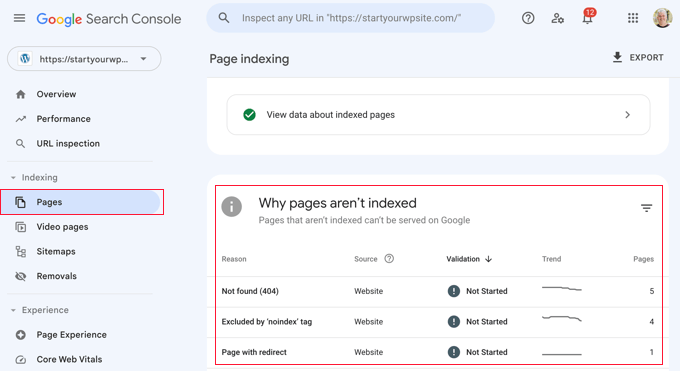
Daha fazla bilgi için, web sitesi trafiğini artırmak için Google Search Console’u kullanmaya yönelik ipuçları listemizi okuyabilirsiniz; bu listede araçla 404 hatalarının nasıl düzeltileceğine ilişkin bazı ipuçları da yer almaktadır.
Bununla birlikte, 404 hatası döndüren WordPress gönderilerinin nasıl düzeltileceğine bakalım. Doğrudan farklı çözümlere geçmek için aşağıdaki bağlantıları kullanabilirsiniz:
404 hatalarını kendiniz düzeltmek için zamanınız yok mu? WPBeginner Pro Services size yardımcı olabilir! Uygun fiyatlı Acil WordPress Desteğimiz ile 404 hatalarını, kırık bağlantıları, yönlendirme sorunlarını ve çok daha fazlasını düzeltmek için uzmanlarla çalışabilirsiniz. WordPress sorunları üzerinde stres yapmayı bırakın ve onları düzeltin! Acil WordPress Destek Hizmetlerini bugün planlayın!
Yöntem 1: Eklenti veya Tema Çakışmalarını ve Özel Kod Sorunlarını Kontrol Edin
Bazen WordPress web sitenize eklediğiniz eklentiler, temalar veya özel kodlar kalıcı bağlantılarla etkileşime girebilir veya çakışmalara neden olarak 404 hatalarına yol açabilir. Demo sitemizde araçları test ederken bunu kendimiz bile yaşadık.
Bu sorunu çözmenin bir yolu eklentileri geçici olarak devre dışı bırakmaktır. Eklentiler bazen WordPress’in bağlantıları işleme şeklini bozabilir.
Eklentileri devre dışı bıraktıktan sonra, her bir eklentiyi etkinleştirdikten sonra 404 hatasının yeniden ortaya çıkıp çıkmadığını kontrol ederken eklentileri tek tek yeniden etkinleştirebilirsiniz. Hata belirli bir eklentiyi etkinleştirdikten sonra ortaya çıkıyorsa, suçlu o eklenti olabilir.
Daha sonra bu eklentiyle ilgili çözümler için hızlı bir Google araması yapabilir veya destek için eklenti geliştiricisiyle iletişime geçebilirsiniz.
Benzer şekilde, WordPress temanız da çakışmaya neden oluyor olabilir.
Kontrol etmek için geçici olarak Twenty Twenty-Three veya Twenty Twenty-Four gibi varsayılan bir WordPress temasına geçebilirsiniz. Tek yapmanız gereken Görünüm “ Temalar ‘a gitmek ve varsayılan bir tema üzerinde ‘Etkinleştir’e tıklamaktır.

Varsayılan tema ile 404 hatası ortadan kalkarsa bu, mevcut temanızla olası bir çakışma olduğunu gösterir. Bu durumda temayla ilgili sorunları gidermeyi deneyebilir veya farklı bir tema kullanmayı düşünebilirsiniz.
Öneriler için en popüler WordPress temalarından oluşan uzman seçimimize göz atabilirsiniz.
Yakın zamanda web sitenize kod parçacıkları eklediyseniz, kodda 404 hatalarına neden olan hatalar olabilir. Eklediğiniz koda yakından bakın ve herhangi bir hata tespit edip edemeyeceğinizi görün.
WordPress’e kod parçacıkları eklemenin en güvenli yolu WPCode eklentisidir. Bu eklenti, doğrudan tema dosyalarıyla çalışmadan özel kod eklemenize olanak tanıyarak web sitenizi bozma riskini azaltır.
Ayrıca, WPCode kodunuzda bir hata tespit ettiğinde, snippet’i otomatik olarak devre dışı bırakacak ve kontrol etmenizi isteyecektir. Kodunuzu canlı web sitenize göndermeden önce çalışıp çalışmadığını kontrol etmek için test modunu da kullanabilirsiniz.

Bu çözümlerden hiçbiri işe yaramazsa, kalıcı bağlantı ayarlarınızdaki sorunları gidereceğimiz bir sonraki yönteme geçin.
Yöntem 2: Kalıcı Bağlantı Ayarlarınızı Düzeltin
WordPress gönderileri, .htaccess dosyanızdaki yeniden yazma kurallarıyla ilgili sorunlar nedeniyle 404 hatası döndürebilir. Çoğu durumda, kalıcı bağlantı ayarlarınızı güncelleyerek sorunu çözebilirsiniz.
WordPress yöneticinizdeki Ayarlar ” Kalıcı Bağlantılar bölümüne gidin ve ‘Değişiklikleri Kaydet’ düğmesine tıklayın.

Kalıcı bağlantı ayarlarının kendisinde değişiklik yapmanıza gerek yoktur. Bu, kalıcı bağlantı ayarlarınızı güncelleyecek ve yeniden yazma kurallarını temizleyecektir.
Çoğu durumda, bu çözüm WordPress gönderileri 404 hatasını düzeltir. Ancak, sizin için işe yaramazsa, muhtemelen .htaccess dosyanızı manuel olarak güncellemeniz gerekir.
Yöntem 3: WordPress .htaccess Dosyasını Güncelleyin
Başlamadan önce WordPress.htaccess dosyanızı yedeklediğinizden emin olun. Bir şeyler ters giderse, orijinal dosyayı kolayca geri yükleyebilirsiniz.
Şimdi, FileZilla gibi bir FTP istemcisi veya WordPress barındırma panonuzdaki Dosya Yöneticisi uygulamasını kullanarak sunucunuza bağlanmanız gerekecektir.
Ardından, /wp-content/ ve /wp-includes/ gibi klasörlerle aynı konumda bulunan .htaccess dosyasını bulmanız ve düzenlemeniz gerekecektir.
Dosyaya sağ tıklayın ve ‘Dosya izinleri’ni seçin.
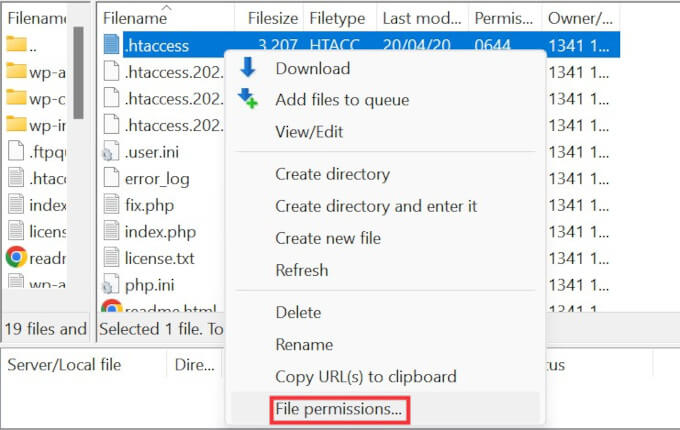
İzinlerini 666 olarak değiştirerek dosyayı yazılabilir hale getirebilirsiniz.
‘Sayısal değer’ kutusuna ‘666’ girin ve ardından ‘Tamam’a tıklayın.

Ardından, eğitimimizin ilk yöntemindeki adımları tekrarlamanız gerekir. Bunu yaptıktan sonra, izinleri tekrar 660 olarak değiştirmeyi unutmayın.
Ayrıca dosyayı düzenleyebilir ve ona kod ekleyebilirsiniz.
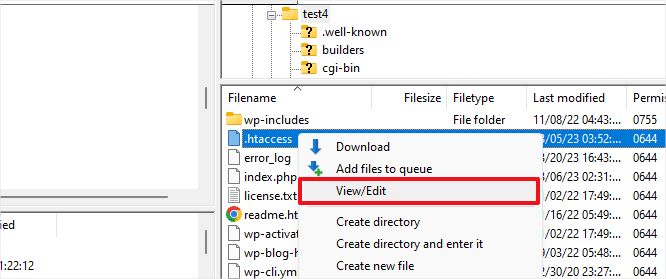
.htaccess dosyasını bir metin düzenleyici ile açtıktan sonra, bu kodu eklemeniz yeterlidir:
1 2 3 4 5 6 7 8 9 10 | # BEGIN WordPress<IfModule mod_rewrite.c>RewriteEngine OnRewriteBase /RewriteRule ^index\.php$ - [L]RewriteCond %{REQUEST_FILENAME} !-fRewriteCond %{REQUEST_FILENAME} !-dRewriteRule . /index.php [L]</IfModule># END WordPress |
Yöntem 4: Hosting Sağlayıcınızla İletişime Geçin
Yukarıdaki çözümlerden hiçbiri 404 hatası döndüren WordPress gönderilerini düzeltmediyse, WordPress barındırma sağlayıcınızla iletişime geçmenizi öneririz. Kendi taraflarında bir hata olabilir veya sorunu gidermenize yardımcı olabilirler.
Lütfen WordPress desteğini düzgün bir şekilde nasıl isteyeceğiniz ve alacağınız hakkındaki kılavuzumuza da bakın.
Yöntem 5: Mod-rewrite’ı etkinleştirin (Yerel WordPress Kurulumu)
Test amacıyla yerel bir sunucu kullanıyorsanız, MAMP, WAMP veya XAMPP sitenizin Apache yapılandırmasında mod_rewrite özelliğini etkinleştirmeniz gerekecektir.
Bu, WordPress’in temiz URL’ler oluşturmasını sağlayacak ve yerel sunucunuzdaki gönderiler ve sayfalar için 404 hatasını önleyecektir.
Bunu nasıl yapacağınız kullandığınız platforma göre farklılık gösterecektir. XAMPP kullanan kişiler kontrol panellerini açabilir ve Eylemler içindeki ‘Yapılandırma’ düğmesine tıklayabilir. Ardından, ‘Apache (httpd.conf)’ seçeneğini seçin.
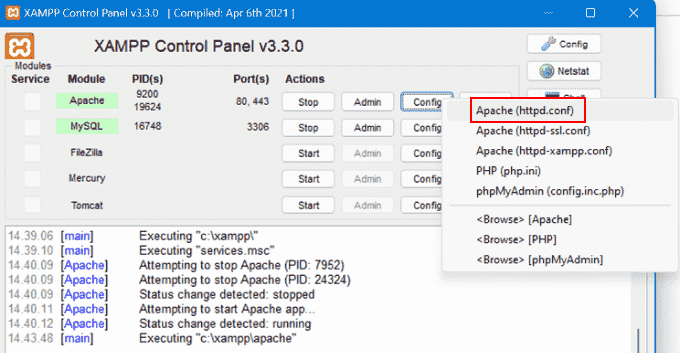
Ardından, #LoadModule rewrite_module modules/mod_rewrite.so satırını bulmanız ve ‘#’ işaretini kaldırmanız gerekecektir.
Bu mod_rewrite’ı yükleyecektir.
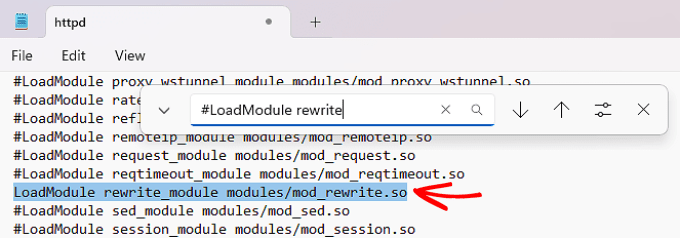
Ardından, AllowOverride None ifadesinin tüm örneklerini bulun ve AllowOverride All olarak değiştirin.
‘Tümü’ değeri, tüm yönergelerin geçersiz kılınabileceği anlamına gelir.

İşiniz bittiğinde httpd.conf dosyasını kaydedebilir ve kapatabilirsiniz. Bundan sonra, XAMPP kontrol panelinde Apache modülünde ‘Durdur’a tıklayın ve yeniden başlatmak için tekrar ‘Başlat’a tıklayın.
Ardından, kalıcı bağlantılarınızın çalışıp çalışmadığını görmek için yönetici kontrol panelinize geri dönün.
Video Eğitimi
Görsel talimatlara ihtiyacınız varsa, aşağıdaki videoyu izleyin.
Umarız bu makale WordPress’te 404 hatası döndüren gönderileri çözmenize yardımcı olmuştur. Ayrıca, en yaygın WordPress hataları ve bunların nasıl düzeltileceğine ilişkin kılavuzumuzu ve sitenizi büyütmek için en iyi WordPress eklentilerine ilişkin uzman seçimlerimizi görmek isteyebilirsiniz.
If you liked this article, then please subscribe to our YouTube Channel for WordPress video tutorials. You can also find us on Twitter and Facebook.





Abs
It helps.. just on permalink, already fix my error..
Thanks for this article..
Julius
Mine is a little different. All the pages are working fine but I get “page not found” when working in some places in the dashboard. Let’s say for example I’m creating a new page from the dashboard. When I click on publish I get a 404 error.
And I’ve tried everything above but it’s not working.
Iron65
Thanks for the tip!! the permalink really saved me!!! In case if any other suffered this by updating Yoast SEO or by just deleting cache, try that one, it will fix it
Monica
I have been trying to fix this permalink issue in my site for months and now I did it with your instructions. I don’t know why I did everything you said already and after writing the 644 permissions to fix the httaccess file, it went back to non-writeable. Now I did it and fixed the permissions and wrote your code and it worked. i really don’t know which was the difference but this time it did. Maybe that I already fixed the httaccess in the original folder where I have a subfolder with my blog. That is the only thing I did differently. Thanks a lot
Rais Dar
I am getting a 404(page not found) on my site. What should i do as i tried your methods but still error persists
Chetan
I had faced the same kind of problem. I used to get 404 Page Not Found error for a page. But the reason was that I and used a permalink slug that was associated with some default page in WordPress. e.g. http://example.com/posts – This is WRONG. Because I cannot use ‘posts’ as permalink slug. It is already reserved for some WordPress page. When I changed it to ‘my-posts’, so that now my permalink read: http://example.com/my-posts, the error was gone!
md
hi ,
i had same htaccess .,however , i delete it and import new one but still same .
dumb
hay guys ….
when i change the permalink to anything other than default, my pages wont work i get this error message
“The requested URL /wordpress/home/ was not found on this server.
Apache/2.4.9 (Win64) PHP/5.5.12 Server at localhost Port 80”
pl help me out
Ian Scofield
I just had this with one of my websites. All of my posts worked fine except for one though. Something was bad about the URL. I had to change the post URL.
neelesh
thanks a lot… ur website has helped me a lot of times and u guys are doing great job. i cant resist myself from thanking you…..
Hardik
Hi Wpbeginner,
Actually I just have migrated from hostinger to one of paid hosting. After migration all things are going good. But when I have tried to edit one my post it regularly shows the following error.
“Page not found error” ‘Apologies, but the page you requested could not be found. Perhaps searching will help.
When I have landed here I have tried all the solutions which you have share.
But nothing is working for me.
Please Help.
Thanks in advance
Hardik
Adrienne
Question? I have an url site, but the data is all new. so there are about 100 old posts that are not longer valid but linked to other sites.. How do I change it to forward to main website, so that Google Search Console can update they crawl records.
I’m looking, but I don’t see anything for posts that have been deleted and getting a 404 error.
Thanks,
David
Thanks was having exactly that issue and this fixed it perfectly!
Mark
Thank you! So nice to find such an easy fix for such a frustrating mysterious problem.
Xavier
Woohoo! Thanks for this. I thought my site content had gone to the birds. Doing the permalink “Save Changes” worked instantly for me.
Pablo
What if it doesn’t work no matter what you do?
HELP!
Fida
Hi Pablo Which server do you use? Shared server or VPS?
Steve Jackson
Thank you for this tip, it was a lifesaver and worked perfectly!
John
Thank you !!!!
abhishek
thank you very much it saved my links pretty well
Hugo Nascimento
Hello guys,
I have the same issue with a client blog. i’m trying to build a custom form inside post page and when I enable the custom permalinks, the form cannot be accessed.
When I change permalinks to default, it works out! :/
Really strange. :/
Sarah
Changing permalinks to default solved my problem too! Thank you!
mojamalenkost
Thank you so much!!!
victor
I have this problem .I can’t login to my WordPress dashboard, each time I try to it keeps giving me Error 404 not found. please help me fix this.
Dont Ask Real Name
Your tip was a life saver. All our posts were just not visible. Your tip helped a lot.
What i did:
Updated .htaccess set CHMOD to 666 instead of 660
Clicked – > Settings -> Permalinks
Clicked on Defaults and clicked Save Changes
Again,
Clicked on Post name and clicked on Save Changes. (since i used custom url that’s why)
You just saved me a ton of headache…
Clive Wales
That was a real life-saver – thought I’d totally screwed up a replacement site I’ve been working on, after trying to be clever with an .htaccess redirection. Thank you!
Marko Liuksiala
Great, that worked – thank you!!
Bill
I like the permalink structure of my posts and they seem to work. I have been using the same structure for several years.
However when I go to Settings–>Permalinks the actual structure is not even listed as one of the options available anymore.
Is this a problem?
Emily
Hi I am having this problem and to be honest, I feel sick because I don’t know what to do. I am a novice really and scared I am going to kill my website more than I already have.
Can someone please tell me what my custom permalink should look like and what I SHOULD hav in my .htaacess file? Right now it seems blank?
WPBeginner Support
Go to Settings » Permalinks choose a permalink structure that you like and then save your changes. Open your .htaccess file and you will notice that WordPress has automatically updated it. If it is blank and your chosen permalink structure is not working, then you can manually add this code into your .htaccess file:
# BEGIN WordPress
RewriteEngine On
RewriteBase /
RewriteRule ^index\.php$ – [L]
RewriteCond %{REQUEST_FILENAME} !-f
RewriteCond %{REQUEST_FILENAME} !-d
RewriteRule . /index.php [L]
# END WordPress
Admin
Viktor
Yes, that was the solution! Thanks a lot. My hosting service changed these settings as I changed the URL to custom error pages but just clicking on the permalink settings fixed that.
Matthew Shelton
“Go to Settings » Permalinks, and simply click on Save Changes button” – fantastic, that worked right away – thanks a lot!!
WPBeginner Staff
Check the .htaccess file.
Gretchen Louise
What about for a single post permalink that got changed and somehow created an internal redirect, and now it cannot be changed back without creating a 404 error? Trying to troubleshoot an issue for a client and wondering where those internal redirects are stored and where in the world to clear them. Thank you.
Thembi Ngema
Dudessss. You guys are legends :)…. Must say I have learnt a lot from you in the past week
bhupendra
hi
thanks I just updated parmalinks structure and site started working
Arpee Lazaro
i just updated t he permalink structures are pictured in this solution and it worked like a charm. thanks!
WPBeginner Staff
Please contact your web host.
Attiq Haroon
I tried the solutions you mentioned in you post bhut it didn’t seems to be working. What happened actually is that I wanted to add a rule to .htaccess file so I downloaded that files from FTP and edited it and uploaded that file again replacing the original one, and then the problem popped up. I have tried a couple of fixes such as deleting and putting new .htacces with default code, removing .htacces file, etc. The only fix that is making the posts accessible is to set the permalink to default option. This makes the posts to work but it can not be a permanent Fix as it is not recommended as an SEO prespective
Please try to find a working solution on that problem
WPBeginner Staff
backup your .htaccess file. Then delete the one from your server. Now log into WordPress admin area and go to Settings -> Permalinks choose your desired permalink structure and hit save changes.
After that connect to FTP and see if WordPress has created a new .htaccess file and it is not blank.
Attiq Haroon
I tried that solution, It created a .htaccess file which looks fine but doesn’t work.
gui
If you have Yoast WordPress SEO or any SEO plugin installed, check your SEO permalink section…
Tim Topham
Hey guys – I recently received an email from Google crawl as I suddenly had a heap 500+ of lost links. It seems that at some stage I must have changed the permalink structure so that lots of the links on old posts have the post date and then post name where as they now just have the post name.
Before I go mad trying to fix 500 links in my articles manually, is there an easy way to update the hyperlinks in articles when this sort of thing happens?
Cheers,
Tim.
Manuel Moreira
I was going insane with this 404 thing after a server move. Thanks for the help guys.
Cindy
thank you! My sites were hacked and all internal pages showed a 404 error. saving the permalink settings fixed it! cheers!
Joe Cutroni
Hi all, I’ve scoured the web to find help to resolve my issue, but
for the life of me cannot get anything to work. Starting just a couple
of weeks ago, all of my back end pages (home page was fine) started
turning out 404 errors on them.
The permalink that I have always used is “Custom structure” (/%category%/%postname%/)…here are some things that I’ve tried:
1 . Gone into my permalinks, clicked “save settings”, and that method provides a temporary fix, maybe for an hour or two, then the 404 errors return on all secondary pages. I’ve also set my permalinks to a different option, such as “Default”, but still get 404 errors shortly after.
2. Completely deleted my htaccess.php file, then went back and saved permalink settings…less than an hour later, 404 errors returned.
3. Commented out this line of code in my function.php file, also completely removed it altogether:
“$wp_rewrite->flush_rules();”. That didn’t do anything. I’ve tried
using both “//” and “#” before it and tested…still get 404 errors.
4. De-activated all of my plugins to see it one of them was the culprit,
but after a short time, my 404 errors resumed while none of the plugins were active.
Like I said, this issue just start a few weeks ago. I use Securi
Security and had them scan my site for any malware, etc…and the site
is clean.
Can someone PLEASE help me with this? Would bigtime appreciate it!
Kyle
Hey Joe,
Did you ever find a workable solution for this? I’ve gone through the same issues that you listed.
David
Hey Guys!
Did you find a solution to the returning 404-error as listed above by JOE CUTRONI?
I’m dealing with the same issue?
Some Feedback would be awesome!
Thank you!
Greetings from Germany,
David
Paul
Hey guys,
you are likely to have a virus on your site.
good luck
Paul
Katie
This is the problem I am having. I moved from WordPress.com to .org and I am at my wits end. I understand the directions that say got admin—> settings —> permalinks. In fact, I remember when I was setting this up that I messed with that particular setting. Here’s my issues: WHERE do I find this admin–> settings–> permalinks?? Is it on my host, in the cpanel? Is it back on WP.com, or if it’s WP.org? And if it’s on WP.org I don’t have a clue how to get to all the admin features of my blog now. When I log in, it shows me my personal profile and allows me to edit it. But not any blog administration. I am at a loss and really losing my head.
Gabriel
If I’m understanding you correctly, just type in the domain name that you activated the wp.org tool and follow it up with “/wp-admin” (for instance “www.example.com/wp-admin”)log in and on the lower left hand side you would find the settings option.
mali suresh
how can change localhost paramalink step by step help me
Srihari K
I had the same problem.. adding the below line in httpd.conf and restarting apache fixed it.
Options +FollowSymLinks
Kym Penrose Clayton
Thank you thank you thank you
Iris Fritschi-Cussens
THANK YOU from the bottom of my heart! I had to delete my .htaccess file due to a hack and then just when I thought everything was fine again nothing worked apart from the home page. Pressing Save Changes on the permalinks solved it in one.
disqus_Hct2NXneXJ
Thanks Man. The Permalink Solution Fixed my Problem. Thanks & Cheers for You!
MEMEME
Thanks! You are God.
L
thanks! I was close to panic…
Thai
Thanks for the post! But sadly I tried these with on the local and nothing worked.. Any other tips?
SemLavana
Thank you. Saved my weekend!